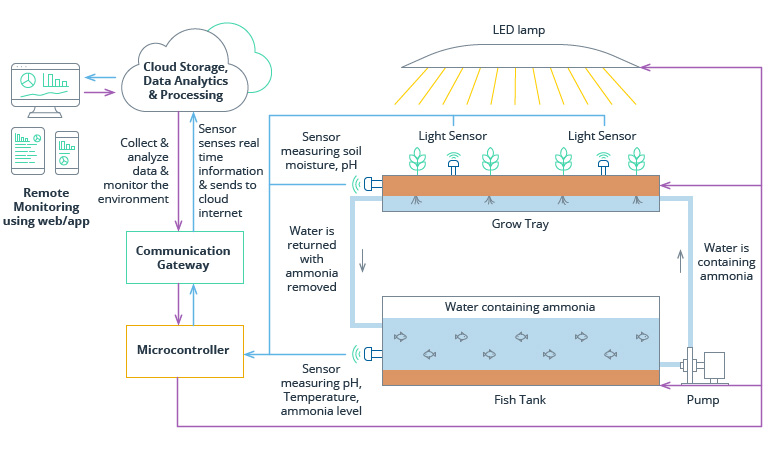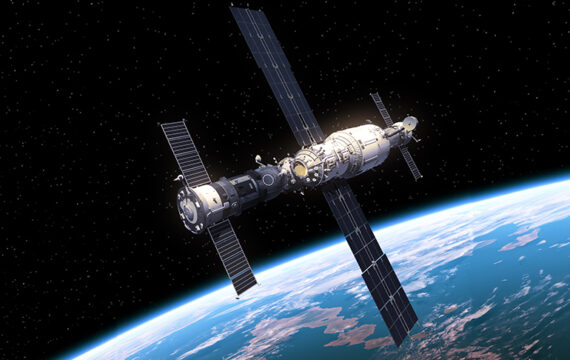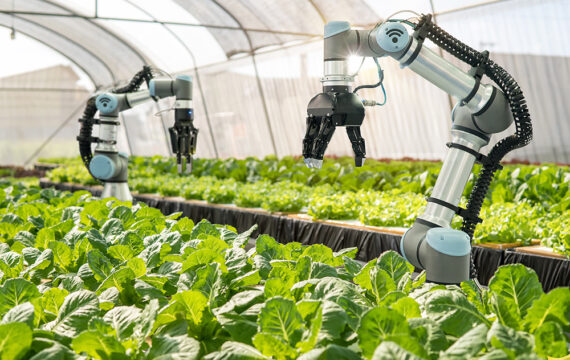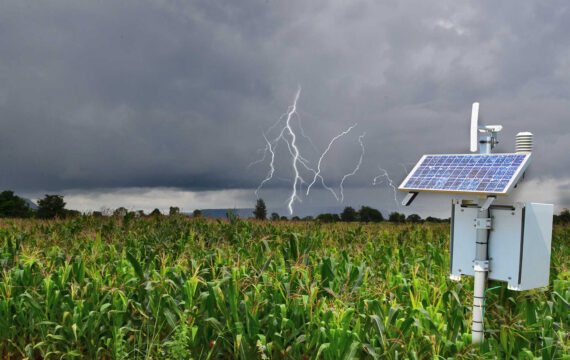Vertical agriculture finds enthusiasts among organizations big and small. Even companies barely related to farming have voiced their support for the development of vertical agriculture solutions.
Microsoft Research highlights greenhouse vertical farming as a perfect way to feed the growing global population sustainably and profitably. LG showcased its own LG: Indoor Gardening booth at CES 2020. Tech companies specifically focused on vertical agriculture like Urban Crop Solutions and Sky Greens are showing the industry how to successfully implement technologies that mitigate our dependence on nature to grow plants.
The population is growing, and resources are running out due to climate change. The natural world is full of uncertainty. Meanwhile, cities are changing their food preferences. People crave healthy, nutrition-rich, tasty, and fresh produce. So if farmland is decreasing and cities are growing, why not consider building a farm on a rooftop or in a supermarket warehouse?
Let’s see what it takes to make vertical farming not only a reality but a profitable business.
What’s inside:
- What is vertical agriculture?
- Advantages of vertical agriculture over traditional agriculture
- Technologies for vertical agriculture and challenges to overcome
- How to make vertical agriculture profitable
What is vertical agriculture?
Vertical or indoor farming is a combination of plant biology, hardware manufacturing, and greenhouse vertical farming software. A vertical farm is an enclosed environment providing all necessary resources to grow crops. You can build a farm in reused shipping containers, building sections, and even space stations.
A vertical farm or so-called plant factory supplies plants with the light, atmospheric conditions, temperature, water, and nutrients required in a controlled and constantly monitored way. Vertical agriculture includes aeroponic, hydroponic, and aquaponic techniques for growing plants. The important distinction of vertical agriculture is the ability to aggregate a high volume of data on plants and turn it into insights for increased yields. On a traditional outdoor farm, environmental factors control how plants grow. In a plant factory, we can control the environmental factors — so we control how plants grow rather than the other way around. And a closed environment is a great way to collect data quickly.
Greenhouse vertical farming is gaining huge popularity in countries with severe climate conditions and in highly urbanized areas. The Asia-Pacific region is among the leaders in vertical agriculture development, while Europe is projected to exhibit the highest vertical farming CAGR of 26% by 2026.
Advantages of vertical farming over traditional agriculture
While traditional in-field agriculture businesses spend billions fighting plant diseases, natural disasters, and herbicide resistance, vertical farms seem to solve all these problems. By going vertical, farmers can focus on quality, nutrition, and the taste of the produce. As a result, products grown indoors can improve health, nutrition, sustainability, and profit for all parties involved.
The most prominent benefits of vertical farming
- The closed environments of indoor and vertical farms minimize the risk of pests and disease, eliminating the use of chemicals, pesticides, and herbicides.
- Applying precise irrigation can reduce water usage by 90%.
- Year-round productivity and resource efficiency allow vertical farms to supply food for urbanized areas and meet growing demand around the world.
- AI-controlled and automated indoor farms help save money on labor and expensive harvesting machinery.
- Software-enriched systems provide constant monitoring and control over farm conditions to ensure the perfect environment for each particular plant.
- Data collected on every aspect of plant growth and climate conditions opens up the opportunity for clear yield projections.
- Savings on countless acres of farmland, machinery, labor, herbicides, and disaster management can offset the higher initial investments in vertical agriculture.
Comparison of traditional farms, greenhouses, and vertical indoor farms

Source: Urban Crops Solutions
Talking about the benefits of vertical farming, we can project a future where supermarkets produce food right in their warehouses. Smart buildings can maintain vertical farms on the roof or in some other area to supply neighborhoods with fresh products. Local indoor farms that can operate no matter the weather can also reduce dependency on imports, lowering food prices.
Vertical agriculture technologies and challenges to overcome
Growing plants indoors means saving them from environmental factors that create a lot of guesswork for farmers. Still, greenhouse vertical farming faces a number of challenges. Vertical farms must precisely meet all plants’ needs. For this, they should rely on technologies that eliminate human mistakes and accelerate actions that should be taken if a plant’s condition changes. Late adjustment can harm a plant no less than changing weather.
Challenges of developing vertical agriculture
- Higher initial investment in technologies and equipment like containers, sensors, LED lighting, and smart irrigation software
- Lack of technology providers with ready solutions for affordable prices
- Limitations on crop varieties that can be grown indoors with the same or higher profit than their counterparts grown outdoors
- Higher energy consumption for all equipment and need to maintain an optimal environment
- Collaboration between different parties to get the required equipment, software, and experts for vertical agriculture development
- Uncertain demand for products grown on vertical farms due to higher prices
- Lack of regulations and established standards for product quality and transparency of origins
- Lack of publicly available data on how to implement the right mix of technologies and successful plant recipes
A big part of these challenges can be leveled by custom AgriTech software solutions that rely on technologies adopted from other fields.
Applying AI and data analytics to overcome challenges in vertical agriculture
Machine learning and AI to reinvent nature
Establishing a vertical farm and running all the operations manually would require a large workforce, extensive planning, and time spent on repeated tasks. Instead, vertical farms can rely on machine learning algorithms to analyze dozens of combinations for the best so-called plant recipes and automatically adjust indoor conditions.
Artificial intelligence system can control vertical farm lighting, recognize deviations in plant development with image processing, automate seeding and harvesting with robotics, and forecast demand in targeted areas. Automated control over a farm can save on energy and help you use resources even more efficiently. We call the needs of a plant ‘a plant recipe’. The plant needs light, carbon dioxide, nutrients, and water. There are so many combinations. Until now we have only been able to find set points on some of the combinations. So we need AI’s help to find more combinations for numerous plant recipes.
Advanced analytics to dig deeper into data, not soil
Vertical agriculture is all about the data you can aggregate around the farm. To make sense of farming data collected on plants, climate conditions, expenses, and potential profits, farmers need to structure, analyze, and visualize tons of real-time measurements. Apart from a sophisticated network of sensors installed across the farm, data processing requires reliable cloud infrastructure for smooth operations.
In terms of data security and food chain traceability, the blockchain enables both food producers and consumers to track all stages of plant development, from buying seeds to delivering products to retailers. Applying data for vertical farms helps agribusinesses manage costs, better understand customer preferences, and make the final product healthy and tasty.
What a vertical agriculture solution looks like

How to make vertical agriculture profitable
Vertical agriculture is the future. It solves so many problems traditional farming has been facing for ages. But one problem still exists, and it discourages agribusinesses and tech companies from going vertical: It’s not easy to implement greenhouse vertical farming technologies to make it profitable at scale.
Vertical agriculture requires many initial investments and high ongoing costs for electricity, building rent, and computing power. This makes the final price of vertically farmed products higher than the average cost on the market. For example, if you grow wheat and want to substitute the traditional in-field method for an indoor farm, the final price for a loaf of bread could be around $11. Even if you sell this bread as local, eco-friendly, and of exceptionally high quality, the price will bite regular consumers.
To make a vertical agriculture business profitable, you should consider several factors that influence ROI: the market size, crop variety, indoor system scalability, and level of implemented technologies.
When building a vertical farm, you should focus on neighborhoods as your target markets. The main benefit of vertical farming is the ability to produce fresh food, which means the delivery time should be as short as possible to get it on customers’ tables. This also makes it difficult to scale a vertical farming business, however. You have to establish a local presence in targeted areas close to your customers.
Technology scalability can be expensive if you need to establish your own IT infrastructure to run software and implement AI,ML, big data, or IoT in agriculture. Often, when buying a ready solution for vertical farms, you will pay more to scale it on new farms. SaaS business models that offer subscription-based access to software can save a lot of money. With SaaS solutions, you pay only for the necessary technology instead of buying an entire suite of tools. It means you can exclude, for example, the agricultural drones data interpretation, if it’s not applicable to your business.
Custom vertical software development and custom software design are often seen as a costly option. But by investing in your own vertical agriculture solution, you’ll be the one who chooses what functionality to implement. Ultimately, you can later sell your solution on the market at scale to empower other farmers with the right set of technologies.
In theory, vertical agriculture could be used to grow any type of crop. Still, there are several types of products that are most suitable for growing indoors: leafy greens, climate-dependent fruits, and herbs. Some high-calorie crops including rice, wheat, and vegetables like potatoes will continue to be grown in a traditional way. In 10 years, it is very possible that many apartment buildings in cities will have their own indoor farms. In a few years’ time, there will be a lot more online delivery companies. So, you can grow indoors and package at your farm. Your customers will just go online and order a delivery. The time from farm to your fridge could be around two hours or so – just like a pizza delivery now. It means fresh, locally available, cheaper and healthier food for potentially millions of people.
Final word
Vertical agriculture has the support of big enterprises, AgriTech startups, software vendors, farmers, and customers. Food is a product that’s always in demand. The higher prices of products grown indoors can be compensated for by a well-defined strategy, customer centricity, and advanced technologies.
Do you have a vertical agriculture project and need some advice or expertise in engineering scalability and advanced technologies? Choose Intellias as your AgriTech engineering partner and we’ll help you solve your challenges.
Contact us to accelerate your time to market, adjust an already marketable product, and step up big from a vertical agriculture concept to a profitable solution.




